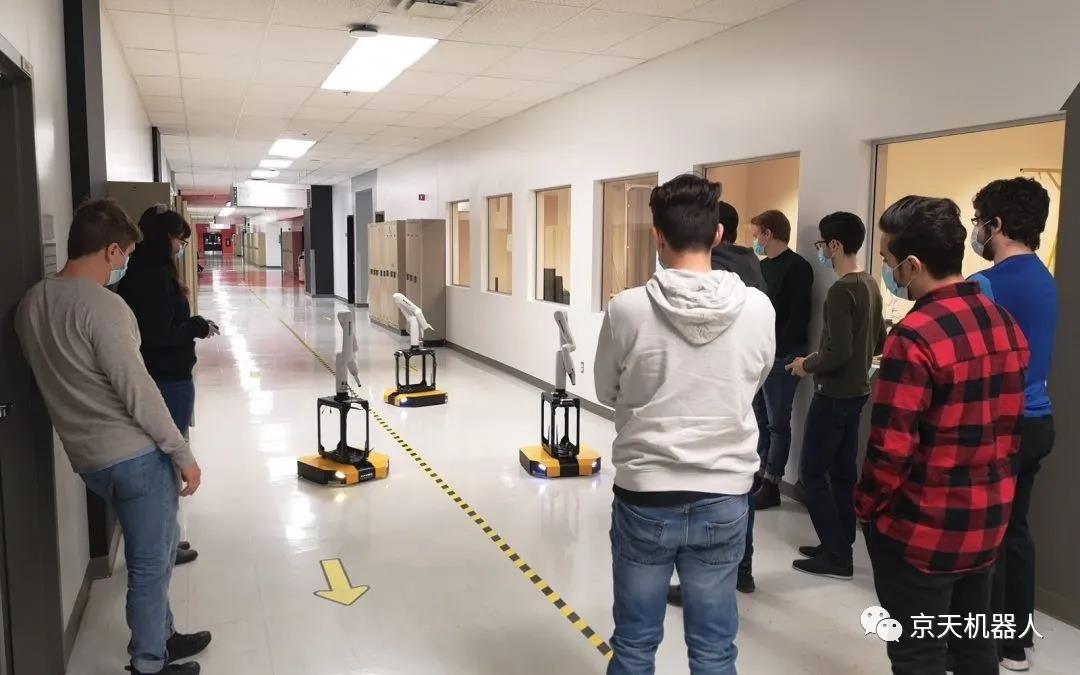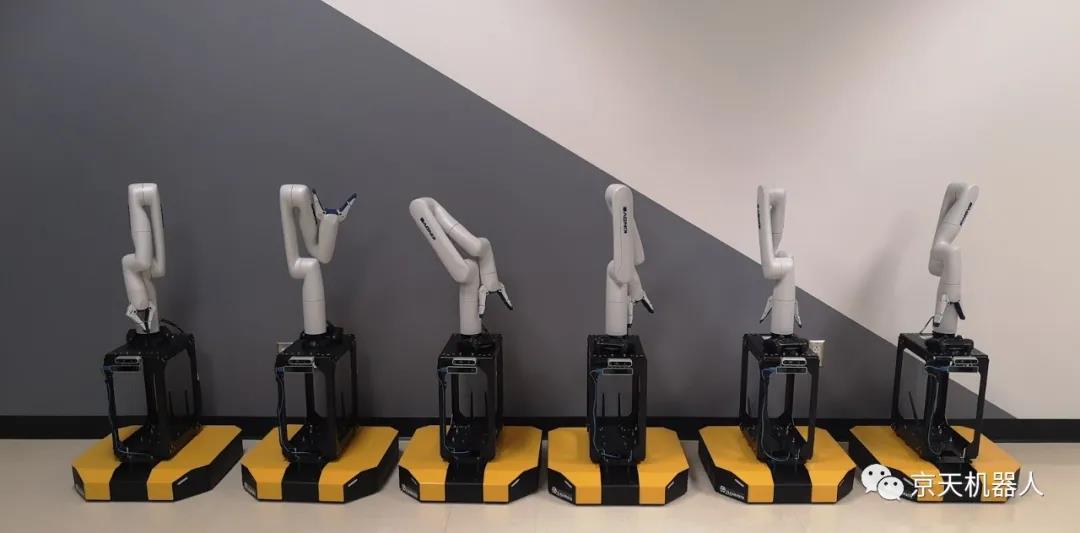Introduce the mobile grasping robot to the laboratory
The staff of ÉTS Lab Lab INIT robots is the team responsible for handling these new robots. University-trained engineers specializing in the needs of the industry. Lab INIT Robot is a research and teaching group that aims to control the mobile robot system intuitively and naturally. They conduct research and training activities related to path planning, collision avoidance, operator ergonomics, robot performance movement and robot swarm control.

Currently, the Dingos toolkit of the laboratory is being used in two new ÉTS courses: MEC744-Robotic Manipulators and MEC745-Mobile Robotics. Teaching laboratories are established in two different situations in order to connect students' work with practical applications. The robot manipulator course simulates the machine maintenance program in the manufacturing plant, integrating safety measures, risk assessment and mastering methods. On the other hand, the "Mobile Robot" course will simulate search and rescue applications, and first responders need to remotely operate reconnaissance robots. Both courses combine theoretical knowledge with hands-on learning and application through teaching laboratories. Under the guidance of Lab INIT Robots graduate students, a team of three to four undergraduate students completed these experiments. This collaborative environment is essential to promote three main learning experiences:
1. Gradually become familiar with Python Notebooks and ROS.
2. Apply specific complex concepts, such as inverse kinematics of manipulators, Kalman filtering, etc.
3. Use all available tools to solve complex robotic problems.
Click the link to watch the video: https://mp.weixin.qq.com/s/oJ-SX2BofX2cHl68mqbOvQ
Robots are highly multidisciplinary in nature. A semester outlines its challenges, which requires a solid foundation like Dingo. The out-of-the-box ROS support allows us to integrate code to handle complex topics (such as mapping, navigation, state estimation, and inverse kinematics) without much overhead. "
–—— David St-Onge (Associate Professor and Director of Lab INIT Robotics)
Accelerate learning with ROS support
The most common challenge facing the laboratory is to allow students to focus on the mechanical aspects of these projects, rather than making them invest too much energy in the programming infrastructure. The learning curve for ROS can be very steep, and since students are mainly from mechanical engineering majors, their programming skills are usually limited. Therefore, the team developed a complete simulation-to-realistic teaching stack, including remote servers on ÉTS, simulation rendering in the browser, and programming via Python Notebooks.

ÉTS laboratory DIT robot set equipped with a vision system and Kinova Gen3 lite robots (8 in total, 6 in total)
Through this setting, students can learn how to use ROS without worrying about the trouble of setting up the system. This is especially important in an educational environment, because in this environment, students want to get started quickly and gain valuable hands-on experience. Robotics students may come from a variety of backgrounds or courses. In these backgrounds or courses, ROS is likely to be their novice. As the head of the laboratory, David St-Onge, said: "Robotics is highly multidisciplinary in nature. A semester outlines its challenges and requires a solid foundation. ROS enables us to operate in the laboratory. Complex topics such as mapping, navigation, state estimation, and inverse kinematics are integrated into it without much overhead."
Therefore, Dingos' out-of-the-box ROS support forms a knowledge base that students can take advantage of and accelerate learning quickly by jumping into more advanced tasks. For example, the laboratory worked closely with its faculty, staff and graduate students to build its own ros_control driver for Dingo so that students can play with the wheel encoder and inverse kinematics programming. By learning to drive the robot manually, they will access the wheel encoder, IMU and wheel motor to build their own drive controller. At the end of the experiment, students need to complete complex tasks, such as establishing an intuitive interface to semi-automatically control a reconnaissance robot, or safely deploying machine maintenance robots in a manufacturing environment.
Bring mobile crawling to the classroom
The core determinant of bringing a pack of Dingos to the laboratory is the robustness and affordability of the platform, which can be extended to the classroom level while maintaining a teaching laboratory for many years, especially with the strong support of ROS. The ÉTS team clearly focuses on students with different levels of education and experience, so they know they want a solution that can integrate future roboticists into the ROS community. In addition, the team hopes to motivate students by engaging students in local sourcing work. Although its robust construction is essential to the learning environment, the laboratory also emphasized the platform's ability to be easily extended with sensors and other features. The team is currently working to integrate locked emergency stop switches to improve Dingo's safety and protect its use on campus.
In order to carry each Dingo's sensor stack, the laboratory created its own turret, so they can add two Intel Realsense cameras (T265 and D435i) and Kinova Gen3 lite robot manipulator. The height of the turret allows the functions of ordinary rooms to be added to the work space of the arm, namely door handles and parts placed on the table/table. The height of the camera also helps to cover a larger area. Both the camera and Gen3 lite are ideal choices for the laboratory because they are easy to use, easy to implement, and most importantly, the arm is inexpensive enough to equip the entire classroom.
The future of DINGO
The Dingo package is still a relatively new feature in the university infrastructure, but they have ambitiously planning to add a third course on mobile operation challenges (control, path planning, integration, etc.) to the course. They believe that the size of their robot fleet (eight platforms) is also crucial for conducting research on human-group interactions and testing certain algorithms. Currently, they are still enhancing many small features (software and hardware) of the teaching infrastructure because the infrastructure was first deployed in the fall (2020).
Course reference
Robotic Arm Course:
This course introduces the concepts of forward and inverse dynamics, Jacobian dynamics and manipulator dynamics.
At the end of this course, students will be able to:
Draw direct kinematics equations of serial or parallel manipulator architecture;
Obtain the representation of inverse kinematics to control the manipulator;
Identify the characteristics of the building and the configuration of the manipulator by analyzing his Jacobian law;
Propose a manipulator architecture suitable for the geometric requirements of the task.
Reminds you of the kinematics and dynamics of rigid bodies in space. Manipulator overview: history, definition, classification and application (industrial and commercial). Kinematics and dynamics of manipulators: geometric design (serial and parallel), forward and inverse kinematics, Jacobien (calculation and analysis), velocity calculation, trajectory planning and programming. A laboratory for processing simple kinematics and programming of commercial robotic manipulators.
Mobile Robot Course:
This course introduces the key concepts of mobile robots in mechanical engineering: from mobility to ergonomics.
At the end of this course, students will be able to:
Distinguish the particularity of the main movement modes (propeller, legs and wheels);
Derive the motion dynamics equation of the simple robot platform;
Determine the required sensors according to the task and environment of the robot;
Estimate the installation of the robot by incorporating certain sensors;
Establish usability studies (methodology, ethics and analytical tools) for robotic systems.
Basic knowledge of manipulators, their dynamics, usability and intelligent control. Overview of the main components: actuators and sensors (sonar, laser, camera and inertial unit). Modeling and design of motion systems: on wheels, feet and propellers. The robot's state estimation (position and orientation). User-centric design: methods and tools. Overview of robotic machine learning applications and deployment tools.
The laboratory is responsible for controlling the commercial robot platform on wheels and the interaction with its operators.

Donghu Robot Laboratory, 2nd Floor, Baogu Innovation and Entrepreneurship Center,Wuhan City,Hubei Province,China
Tel:027-87522899,027-87522877
Robot System Integration
Artificial Intelligence Robots
Mobile Robot
Collaborative Robotic Arm
ROS modular robot
Servo and sensor accessories
Scientific Research
Professional Co Construction
Training Center
Academic Conference
Experimental instruction
Jingtian Cup Event